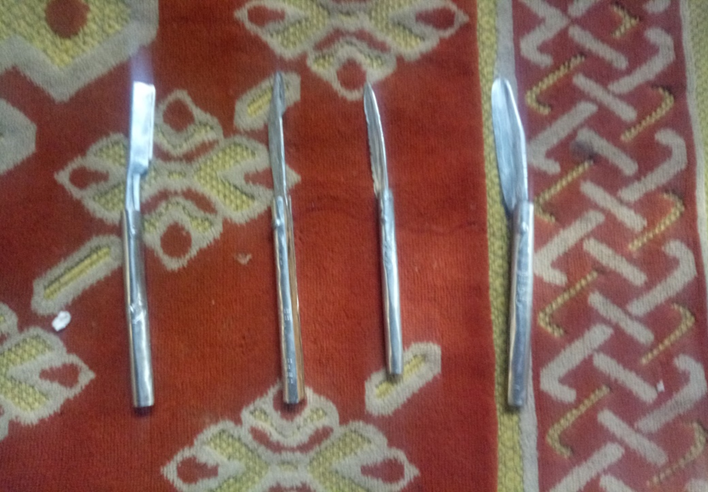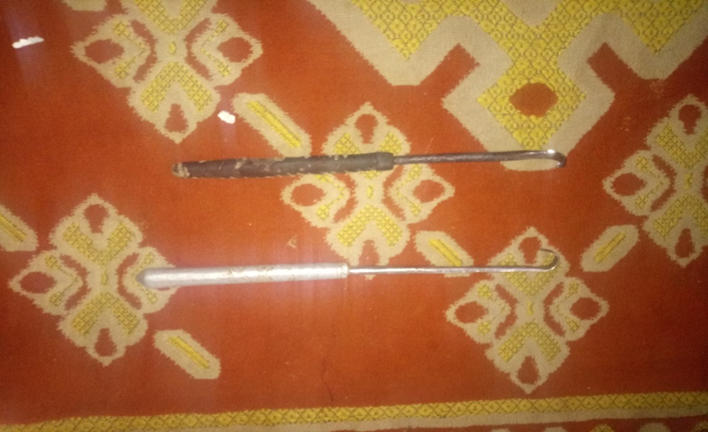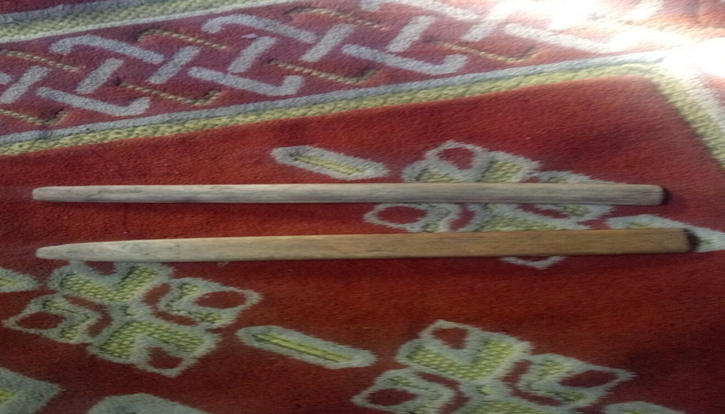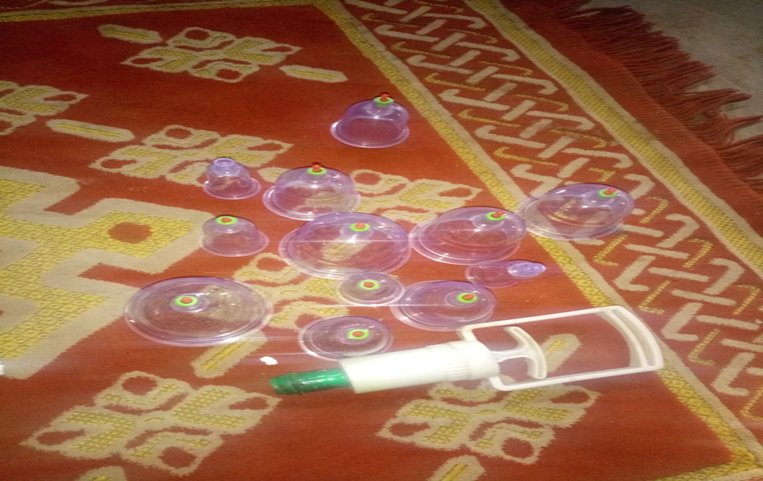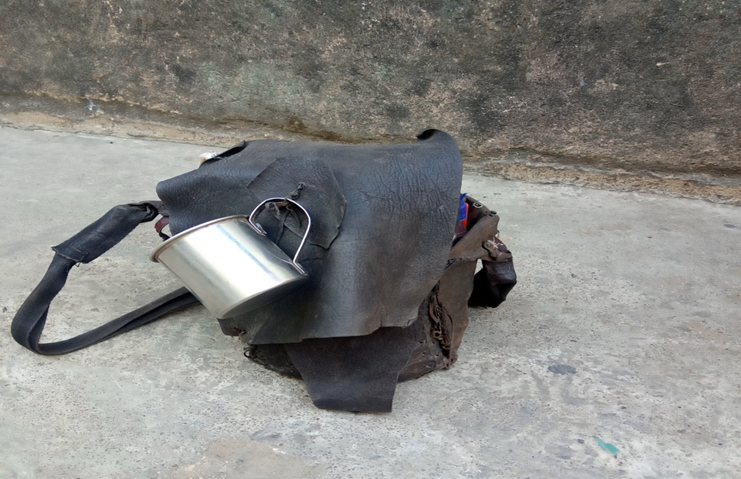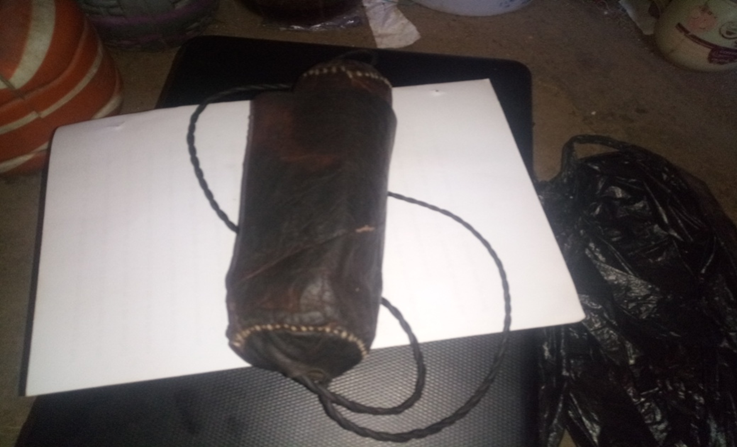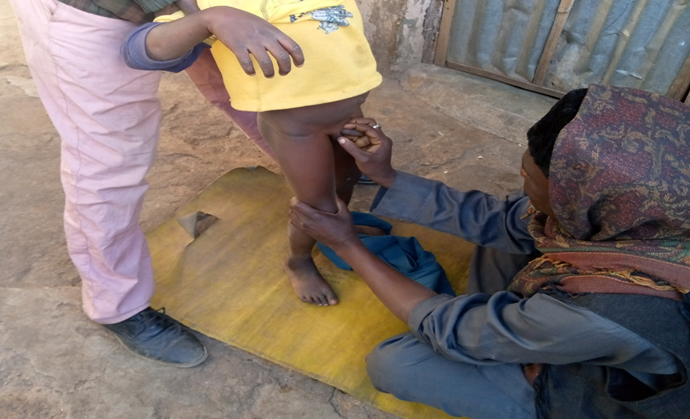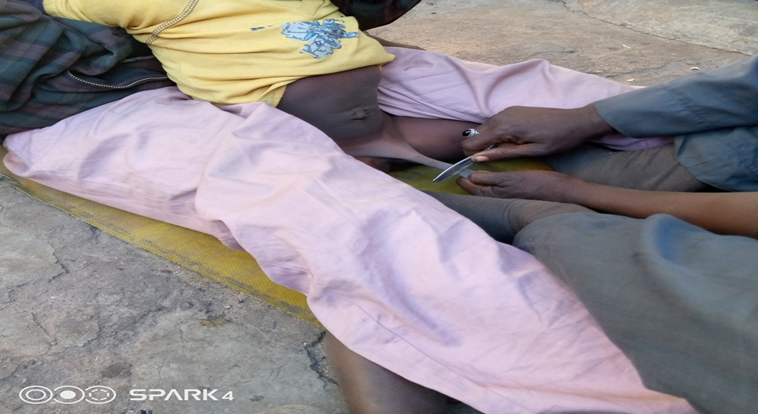Research Article | DOI: https://doi.org/10.58489/2836-2284/005
An overview of Wanzanchi: The Traditional Surgeons of the Hausas, a culture historic perspective of Jos North Plateau State Nigeria.
*Corresponding Author: John Paul Nkwap
Citation: John Paul Nkwap (2022). An overview of Wanzanchi: The Traditional Surgeons of the Hausas, a culture historic perspective of Jos North Plateau State Nigeria. Journal of Skeleton System. 1(1). DOI: 10.58489/2836-2284/005
Copyright: © 2022 John Paul Nkwap, this is an open access article distributed under the Creative Commons Attribution License, which permits unrestricted use, distribution, and reproduction in any medium, provided the original work is properly cited.
Received: 30 July 2022 | Accepted: 20 November 2022 | Published: 18 December 2022
Keywords: traditional surgeon, malaria, pile, gonorrhea.
Abstract
The aim of this research is to document the history and cultural practices around Wanzanchi, with emphasis on the significant roles it plays in the Hausa community. This is achieved through the collection and documentation of oral tradition on the history, origin, development, impact as well as the value of the craft as an aspect of the culture history of the Hausa people and to study the material culture involved in the activities of Wazan and to document the cultural practices around it.
Introduction
Wazanchi, an Hausa word that entails the cultural practices around the craft Wazan which can be referred to as a traditional surgeon in Hausa land. Traditional surgery (Wanzanci) is one of the oldest professions among the Hausas’ ethnic group of northern Nigeria. It has been one of the oldest craft, a means of survival and a way of sustaining their livelihood as well as their local economy since the earliest times and has been passed on through successive generations till date. Hence, the Wazan (traditional surgeons) occupied the position of doctors or healthcare providers in the past through administering treatments to various ailments and provides cure for certain diseases such as Basir (pile) shawara (typhoid), chutar cizen sauro (malaria), toilet infections (gonorrhea) and spiritual ailments such as certain charms against witchcraft, madness among others.
The aim of this research is to document the history and cultural practices around Wanzanchi, with emphasis on the significant roles it plays in the Hausa community. This is achieved through the collection and documentation of oral tradition on the history, origin, development, impact as well as the value of the craft as an aspect of the culture history of the Hausa people and to study the material culture involved in the activities of Wazan and to document the cultural practices around it.
Recently, the profession is facing the threat of going into extinction due to the emergence of modern day medicine and surgery (Sallau, 2014). People no longer patronize their services especially for the various health risks involved in the services they rendered.
The Gidan Magajin Aska of Jos is famous for the traditional surgery as it has been their heritage for many generations in the past. The overall chief or leader of the traditional surgeons (Sarkin Aska) always comes from the family and they have the absolute control of all the affairs of the chiefdom as well as the craft. The Gidan Magajin Aska of Jos is located at the central part of Jos North Local Government Area at Zololo Junction on Latitude 90 55’ 42.906’’ N and Longitude 8053’ 29.916’’ E.
This study is relevant to the culture and tradition of the Hausas’ because it contributes significantly to the rich culture and heritage of the people under study.
The people who occupy the study area according to oral tradition are originally from Fuskar Yama in Katsina state who is also part of the Muslims located in the northern part of Plateau State.
Aim and Objectives
This research is aimed at studying Wazanchi among the Hausas and to document the cultural practices around it with emphasis on the significant roles it plays in Hausa community, this can be achieved through the following specific objectives.
- To collect and document oral tradition on the history, origin, development, impact as well as the value of wanzanchi as an aspect of the culture history of the Hausa people.
- To study the material culture involved in the activities of wanzanchi.
- To document the cultural practices around wazanchi.
Geographical Location
Jos North Local Government Area is located on the Jos Plateau at about 1,238 meters or 4,062 feet above sea level, on Latitude 090 55’ 00’’ N and Longitude 080 53’ 25’’ E. The city has an estimated population of 810,100 based on the 2015 count. The Gidan Magajin Aska of Jos is located at the center of the Jos City (precisely along Bauchi Road, Zololo Junction). The area is approximately 450m west of the Jos Central Mosque and approximately 852m south of the Jos Main Market.
Figure 1: Map of Nigeria showing the study Area.
Source: Department of Archaeology and Heritage studies, University of Jos.
Methods
In order to achieve the research set aim and objectives, the following methods were employed in order to get the required information necessary for the purpose of this research:
Oral tradition
Vansina (1985) defined Oral traditions as verbal messages which are reported statements from the past beyond the present generation. Oral traditions are messages or set of information stored in the human mind or memory that are being passed through successive generations by the word of mouth.
Oral tradition has been useful in archaeological research especially in locating sites, in analyzing and dating of the cultural materials recovered from the site, and for the interpretation of collected data. Despite its usefulness in archaeological investigation, the validity of the use of oral tradition in archaeological investigation has been questioned by scholars. One of the grounds is that people can recite two or more versions of the same tradition and those in the society who hold the tradition can suffer memory loss (Effah-Gyamfi, 1986 cf. Nkwap 2022). However with all its shortcomings, oral tradition remains one of the major sources for the reconstruction of African history (Boachie-Ansah, 1984 cf. Nkwap 2022).
Thus, an oral interview that cut across people of different gender, occupation, social background and age was conducted. This was to enable the researcher acquire information on the people’s origin and migration history and to determine the level at which Wanzanchi is popular or known among the people and especially the younger generation. To collect different versions of oral information for better understanding, to ensure gender sensitivity and ascertain gender role particularly on the traditional secret cult. This method provides the researcher with information on the origin and development of the craft, the factors that gave rise to the evolution of the craft. Oral tradition also helped the researcher in the identification and interpretation of the material culture involved in the craft. This information was audio recorded and some were transcribed on paper.
Furthermore, ten (10) persons were carefully selected for the interview on the basis of their affiliation to Wanzanchi and Hausa culture history irrespective of their gender, age, religion and social background. Structured questions which yielded the required information were asked during interview. This guided the researcher to acquire valuable information. Individual interview was employed when necessary to provide a more conducive atmosphere for better interaction. This is because some people are uncomfortable while speaking in public and it also enabled the respondents to freely express their views without fear or favour. However, group interaction or interview was also employed which was of great significance because individuals with better knowledge were able to checkmate and correct mistakes that were made by others during the interview. It also gave room for the younger ones to acquire more knowledge about the craft, their people and their culture.
Ethnography
Ethnography is a qualitative methodology that lends itself to the study of the beliefs, social interactions, and behaviors of small societies, involving participation and observation over a period of time, and the interpretation of the data collected (Denzin and Lincoln, 2011; Reeves, Kuper and Hodges, 2008; Berry, 1991 cf Nkwap 2022). It is also a systematic and descriptive study of a contemporary or extant culture, people and civilization in order to understand specific and basic aspect of a people’s experiences and culture.
Ethnography provides the researcher the opportunity and privilege to interact, participate, witness and observed some of the activities of the Wazanchi.
Using this method, the researcher observed some of the activities of the Wanzan through the material culture of the craft as to gain practical knowledge of the Wazan activities and for better understanding of the cultural practices around it for the purpose of recommending that aspect of Hausa culture heritage for archaeological research. But in situations whereby the researcher could not directly participate, probably during rituals meant only for patients or members of the craft observational approach and oral interviews were employed.
Written documents
Written documents relevant to this research were collected and reviewed. This provided the researcher with background information which created the path to follow in order to achieve the set objectives. These written materials were a combination of both published and unpublished works and archival materials sourced from National Library Jos, Plateau State Library, University of Jos library, Department of History and International Studies library, pamphlets published by scholars and researchers alike. Archival materials were also consulted such as Gazetteers of the Northern provinces of Nigeria.
These written sources were properly and carefully studied and used alongside oral tradition which helped in providing information that was not collected through oral interview, and these written documents helped in providing the correct spelling of indigenous words and were also used to form the basis for a broad literature review on the subject matter. This has revealed various information about the traditional surgery among Hausa people in Jos North and some other parts of Northern Nigeria. This has helped in understanding the various aspects of the profession the technical know-how its evolution and how it has being passed from one generation to another. Some of the written documents contained spontaneous data concerning the practices and functions of traditional Hausa surgeons.
An Ethnographic study of Wanzanchi in Jos North.
Origin and Development of Wanzanchi in Jos North
In African society, the doctor, pharmacist or healer was a person of immense social standard and significance. He is considered as the greatest gift from God, the most useful source of succor and help in otherwise harsh environment (Onu, 1996 pp 4). For most African folks, health was as much a condition of the soul as of the body (Andah 1988 cf. Maamun 2020).
The history of how and when traditional surgeries began in Hausa land is still not clear. But for centuries, the people in Hausa land have devised various healing processes and methods (Sallau 2013). Although some people have related the history of the profession to the advent of Islam in Hausa land because Islam encouraged so many of the practices carried out by the Hausa traditional surgeons. In some accounts, it is maintained that Prophet Muhammad (PBUH) has his personal surgeon, Harash Ibn Umaiyah Fadul whom on various occasions cuts the hair of the prophet and performed cupping i.e., removal of hematoma (Sheriff 2000:6 cf. Maamun 2020). As a result of the penetration of Islam into Hausa land, certain people adopted and modified the practices (Abdallah 1981).
The act of traditional surgery has been a trans-generational heritage among the family of the Gidan Magajin Aska of Jos from time immemorial. The most easily fetched platform for the acquisition of the knowledge system, is done through apprenticeship and training via frequent visual observations. That is to say, local surgeons or Wanzamai carryout all their jobs without any form of formal training except for close observations if and when necessary particularly when their parents are doing it.
Traditional practitioners also train their siblings by taking them to circumcision and other events related to their job at a tender age (between age 5-10) and as time goes by, perfection is gained, and they are at this point expected to commence the trade. This was in line with the acclamation of Mallam Is’haq Danjuma who at the course of the research divulged that he started conducting circumcision professionally at the age of 12, after he visited many circumcision events (scenes) with his father and having watched him carefully and closely conducting, he gained perfection. The first circumcision he was said to have performed was on a 14 days old baby.
Historical Background of Gidan Magajin Aska of Jos
“Magajin Aska or Sarkin Aska” is a traditional title given to the person who spearheads the activities of the traditional Hausa surgeons (Wanzamai). The Magajin Aska also has a council of chiefs (cabinet) with various titles like “The Dan Iyan Aska” (who is a helper to the women surgeons), “Ciroman Aska” (Special Adviser), “Wazirin Aska” (The Vizier), “Galadiman Aska” (Minister) and many others. These cabinet members are more like decision makers about the profession of traditional surgery in Hausa land.
The Magajin Aska of Jos is in charge of all the affairs of the traditional surgeons within Jos North. According to oral informant, Malam Is’haq Danjuma (pers comm, 2019) who narrated that the family were said to have migrated from Fuskar Yamma Village (now a district) in Katsina, Katsina State. They settled briefly at Faskari village of Funtua Local Government of Katsina State before moving to Jos around 1899. On their arrival to Jos, they settled in Naraguta Village for many years before moving down to Jos town.
The reason behind the migration of family of the Magajin Aska of Jos is obscure however in one version of their history, the migration according to Baba Kande Ilyas (pers comm, 2019) informed that they migrated from Fuskar Yamma due to leadership clashes and tussles among the traditional surgeons as of that time in the village which caused a serious faction and misunderstandings among the family members. In another version of the history according to Alhaji Ali Baba Ilyas (pers comm, 2019), the family migrated out of Fuskar Yamma due to an unknown epidemic that consumed a lot of lives of members of their community.
The first Magajin Aska of Jos was Malam Iliyasu Abubakar Aliyu. He left Naraguta Village for Jos when he was appointed as the interim Emir of Jos in 1928/29 prior to the appointment of Sarki Isyaku (as emir of Jos). His eldest son, Alhaji Danjuma Is’haq Ilyas took over as the Magajin Aska of Jos till his death in 2010. After his death, Malam Is’haq Danjuma was appointed as the Sarkin Aska of Jos from 2010 till date. However, the Gidan Magajin Aska of Jos has been in existence for almost 100 years.
The members of the family of Gidan Magajin Aska of Jos have a unique scarification (Zane) on each side of their faces. A total of 12 strands of a mark are drawn on the face with each side having 6 strands (three of the strands drawn up and another three beneath). The scarification is done basically for the purpose of identification and differentiation between one clan from another.
However, the informant maintained that this has been a profession which their parents also inherited from their forefathers, although it was obvious that no one could say when and how this knowledge was acquired within the family. It is usually passed to the younger ones through careful observation.
It is part of the ethics of the profession and that of the family that no one is allowed to carry out any surgical operation with seeking permission of the Sarkin Aska. This is based on the fact that certain surgeries are considered intricate that only a professional in the job can carry them out.
Women are also trained as traditional surgeons but their roles are restricted to taking care of fellow women’s health needs. Mostly, the women help in the areas of child delivery, female genital mutilation and so on. The restrictions are as a result of the inclination of the profession to the religion of Islam.
The Gidan Magajin Aska of Jos have been living peacefully with all the people of the communities around them and they are very accommodative and helpful to any one that requires their services. Also, the family members married from outside the family.
Festivals of the Gidan Magajin Aska of Jos
Basically, the Gidan Magajin Aska of Jos practices the Islamic religion. They carry out festivals such as the Wasan Wanzamai during the Islamic Sallah celebration, naming ceremony, wedding and coronation ceremonies. The festivals are marked with the display of magical and enchanting prowess, skills and heroic displays like: hatching eggs in a calabash within few minutes, drinking of the albumen of an egg and the egg yolk and later giving birth to ducklings, performing cupping (operation of drawing blood from the surface of the skin) on a dry bone, calling of the traditional surgeons kit (Zabira) from a far distance, among others.
Categories of the Traditional Surgeons
According to oral informant, Malam Is’haq Danjuma (pers comm, 2019), traditional surgeons are categorized into two according to how they know the craft with each having its uniqueness and specialty and they include;
- The ones that acquired the knowledge and skill of the profession through inheritance: These are surgeons that acquired their skills by inheritance from their parents. Their duties are not restricted to particular activities. They are however regarded in the past as doctors, pharmacists, dentists, physiotherapists, among others.
- Those that acquired the knowledge and skill through apprenticeship: These group of traditional surgeons are restricted to perform barbing and administering of herbal medicine for certain ailments
Traditional Surgeons’ Tool Kit
The following are the equipment (tools) used by the traditional surgeons when carrying out any operation:
- The surgical knife (Aska)
This is small sharp metallic knife made from a stainless iron. It is used in performing circumcision, haircut, cutting a sealed tongue, scarification and making smaller incisions on the body during cupping. However, different surgical knives are used for different purposes, for example, the surgical knife used for circumcision is different from the one used for hair cut or barbing.
Plate i: Various surgical knives (Aska)
- Koshiya
This is a sickle-like tool that is about 20cm long made also from a stainless iron with a sharp ending, which is used in the removal of uvula and in Hausa it is called Belu.
Plate ii: Koshiya
- Dogari/MadogariThis is a wooden tool that is about 20cm long which is used in suppressing the tongue while removing the uvula.
Plate iii: Dogari/Madogari
- Horn (Kaho)
This is the horn of cattle which is peeled to a desired size of about 25cm with an opening at the upper part. It is used for cupping (removal of hematoma). However, there are modern cupping tools made from plastic which serve the same purpose as the horn. Medically, the modern cupping set is said to be the safest and more hygienic.
Plate iv: Kaho (Traditional Cupping Set)
Plate v: Modern Cupping Set
- Awartaki
This is a scissors-like metallic tool used for removing teeth. According to informant (Mallam Hamisu Ibrahim Aska), the awartaki is not widely used by the traditional surgeons as it is not all of them that professed in traditional dentistry.
Plate vi: Awartaki
Other Accessories of the Traditional Surgeon
- The Surgeon’s Bag (Zabira)
This is a bag made from leather in which the traditional surgeons used in keeping all the tools that are used for surgery. Aside the Zabira, there is also another smaller bag that is called “Tankolo.” The Tonkolo however contains mainly the various surgical knives and other smaller tools.
Plate vii: The Surgeons’ bag containing all his tools
- Tonkolo
A cylindrical shape object from leather with a rope at the other end used to perform certain treatments and the preparation of certain charms.
Plate viii: The Tonkolo
- Zarci
This is herbal concoction of tsada (Spiny Plum/Ximenia Americana) with red potash that is usually used in washing and sterilizing and purifying the tools that are used in carrying out surgeries. The herb is boiled in water with the red potash and al the metallic implements/tools are put together. This is done in order to eliminate harmful germs that can be transferred to other people when carrying out one operation or the other on them.
The Various Services Rendered by the Traditional Surgeons
Being considered as a doctor in the past, traditional surgeon renders the following services:
Barbing
This simply involves trimming or cutting down of hair and the beard. It is carried out using the surgical knife or manual and electric clipper. According to informant (Mallam Hamisu Ibrahim Aska), the use of both the manual and electric clippers began as a result of contact or coming of the colonial masters. The barbing with a surgical knife requires the Wanzami to use water and soap to soften the hair before it is being removed. Today Doctors who need to perform surgery on a patient will cut the hair on the spot that he surgery will be carried out prior to the surgery it is part of modern day medical ethics.
Plate ix: Wanzami in the act of barbing
Circumcision
This is the surgical removal of the foreskin, which is covering the tip of the penis of males and the removal of the clitoris in females (Female Genital Mutilation) using the surgical blade (Aska). The foreskin of the both the male and female genital contains the network of veins which if cut, leads to serious oozing of blood. The traditional surgeon therefore uses a medicinal mixture to stop the bleeding.
However the following are the medicinal mixtures used:
Ararrabi (Burceraceae), Madaci (Black Plant) and Bawon Tsada/Spiny Plum (Ximenia Americana).
Plate x: Wanzami setting the penis’s skin before circumcision
Plate xi: Wanzami performing circumcision
Removal of uvula (Belu)
The uvula is a teardrop-shaped piece of soft tissue that hangs down the back of the throat. It is made from connective tissues, saliva-producing glands, and some muscle tissue.
Traditional uvulectomy is the surgical removal of the uvula by the traditional surgeon. According to Mallam Salisu Aska (traditional surgeon) the removal of the uvula takes a highly professional traditional surgeon as no bleeding is expected after the removal. Also, he maintained that the reason for the removal of the uvula is owing to the believe that it could grow bigger as a child grows and could pose an impediment to speech and can also cause frequent aching of the neck.
Cupping (Kaho)
According to oral informant (MalamAuwalm Ibrahim Aska), cupping is the process removing of hematoma which involves local collection of blood through vessels either because of disease or trauma including injury by a traditional surgeon. A hematoma is initially in liquid form and spreads among the tissues where it may coagulate and solidify before blood is reabsorbed into the blood vessels. He also added that surgical knife or razor is used to make 2 or 3 parallel Velum (balli-balli in Hausa) over the area, with the incisions ranging in length from quarter of an inch in length and a cow horn or the plastic cup of the right size is then placed over the area, and the surgeon creates vacuum by sucking out air through a hole in the tip.
Plate xii: Wanzami Performing Cupping (Kaho)
Facial scarification
This is the process of drawing marks (Zane) on the face using the surgical knife (Aska). When it is performed usually, charcoal powder is rubbed continuously on the area in order to make it indelible.
Plate xiii: Facial Scarification
Tongue cutting
This involves the cutting of a thread-like structure or growth at the lower part of the tongue which causes a sealed tongue that bring about impediment in speech. However, traditional surgeon uses the surgical knife to slightly cut the thread-like structure at the lower part of the tongue.
Relevance of Wanzanchi to the culture and tradition of Hausa people of Jos North.
Its shows cultural contact between Hausas and the Arabs. as evidenced by this craft it is a known tradition that the Arabs seems to be solely responsible for the cutting of their hair as well as other practices associated with Islamic religion, hence it can be inferred that Wazanchi and the practices around it is tied down to some certain Arabic and islamic cultures. In Islam, for example, barbing and circumcision are considered very important rituals which every Muslim must undergo. It is an emphatic way of life of the Prophet for a Muslim to have a haircut immediately he/she is done with the activities of pilgrimage.
Again, circumcision is performed usually on every male Muslim who is more than seven weeks of age as a stage for purification and in adulthood, an uncircumcised male will not be allowed to lead daily prayers or hold any leadership position.
Finally, circumcision is also considered an African tradition owing to the fact that many Africans used it as a means of initiating children into adulthood.
It shows cultural continuity, This research has shown the antiquity of this craft and how overtime it has been passed through successive generations this is achievable because of the reverence attached to the practice of this craft despite being threatened by modern medicine, western education as well as the health risk involved. The antiquity of this craft shows how important this craft is to Hausa thereby contributing to the rich cultural heritage of the people understudy and this has brings about technological advancement as modern medicine and surgery borrowed and developed many concepts from the traditional surgery.
It serves as an employment opportunity to the practitioners. It serves as source of income and livelihood to the practitioners as it also helps in generating revenue to the government as the practitioners pay tax.
Traditional surgery among the Hausa people of Jos has contributed immensely and greatly to the provision of job opportunity. For years, most of the people engaged in the profession have depended on it for their livelihood and that of their families. Some of them used the stipends they generate from their job to send their children to school.
On the other hand, the traditional surgeons have helped and played an important role in the general health care delivery to the society. Before the advent of modern medicine, the traditional surgeons served as general consultants for all sorts of ailments and also reduced the cases of mortality among people.
Contributed in modern day medicine, From the data collected, the research was able to infer that African traditional surgery is not below the horizons of western medical knowledge as always believed by Eurocentric scholars.
Conclusion
This research is in its foundational stage and cannot draw any conclusive information however this article has attempted the use of different sources to achieve the desired objectives. These include the use of written documents, oral interviews and physical observation and participation. The approach yielded useful information about the historical origin of the Gidan Magajin Aska, their socio-cultural, political religious and economic organization. The practice of Traditional Surgery is of immense economic value to the people. It also exposes the political, socio-cultural and religious functions of the craft and the practitioners in the society.
Among the basic problems encountered in the study of Traditional Surgery in Gidan Magajin Aska of Jos, are translations from the native dialect to English especially the name of the tools that are used and plants which serve as medicinal plants used for healing and providing effective healthcare service. This is due to the fact that the area has not been given the required attention which is gradually causing a decline in practicing and patronage of Traditional Surgery.
Despite these challenges, the research achieved the desired objectives, through intentional and a multi-disciplinary approach must be employed to fully study and document the extent of Traditional Surgery in Gidan Magajin Aska of Jos.
APPENDIX
LIST OF INFORMANTS
S/No | Name | Age | Occupation | Sex | Year |
1 | Mallam Is’haq Danjuma | 57 | Traditional Surgeon | Male | 2019 |
2 | Mallam Ali Baba Ilyas | 70 | Traditional Surgeon | Male | 2019 |
3 | Baba Kande Ilyas | 68 | House wife |
| 2020 |
4 | Alhaji Abubakar Agege | 65 | Businessman | Male | 2019 |
5 | Mallam Auwalu Ibrahim Aska | 57 | Traditional Surgeon | Male | 2020 |
6 | Mallam Sadisu Ibrahim Aska | 35 | Traditional Surgeon | Male | 2020 |
7 | Prof. Aliyu Sallau | 62 | Traditional Surgeon/Lecturer | Male | 2019 |
8 | Dan Azumi Wanzan | 81 | Traditional Surgeon | Male | 2019 |
9 | Mallam Hamisu Ibrahim Aska | 39 | Traditional Surgeon | Male | 2020 |
10 | Alhaji Danladi Kuzo | 70 | Traditional Surgeon |
| 2020 |
References
- Abdallah. I.H. (1981). Islamic Medicine and its Influence on Traditional Hausa Practitioners in Northern Nigeria, Unpublished Ph.D Thesis. Madison University of Wisconsin
View at Publisher | View at Google Scholar - Ammy M. (2017). The Editors of Encyclopedia Britannica.
View at Publisher | View at Google Scholar - Andah. B. W. (1988). Africa Anthropology. Shaneson, C.I. Limited, Ibadan.
View at Publisher | View at Google Scholar - Augustine O.O. (1996). Sustainable Health Care Delivery: Indigenous African Medical Practice as a Strategy. West African Journal of Archaeology. Vol. 26(1). Edited by Bassey Andah.
View at Publisher | View at Google Scholar - Hammersley M and Atkinson P. (2007). Ethnography: Principles in Practice. Routledge Taylor and Francis Group. London and New York
View at Publisher | View at Google Scholar - http;//en.m.wikipedia.org
View at Publisher | View at Google Scholar - Ian S. and Jameson R. (1999). A Dictionary of Archaeology. Blackwell Publishers, USA
View at Publisher | View at Google Scholar - Lukman O. and Omotora M. (2012). Community Based Study of Circumcision Practices in Nigeria. Annals of Tropical Medicine and Public Health. Vol. 5 Issue 3. Pp. 231 – 235.
View at Publisher | View at Google Scholar - Malam. D. (2007). Hausa Names for Plants and Trees. Roger Blench. Cambridge, United Kingdom.
View at Publisher | View at Google Scholar - Mbagu G.S. (2018). A Contemporary Geography for Senior Secondary Schools. Book 1. Rasmed Publications Limited. Ibadan.
View at Publisher | View at Google Scholar - Sallau A.B. (2013). Wanzanci da Sauye-Sauyen Zamani. Ahmadu Bello University Press Limited, Kaduna.
View at Publisher | View at Google Scholar - Sheriff. B. (2000). The Kanuri Barber and His Art. Borno Museum Society Newsetter. No 42 and 43.
View at Publisher | View at Google Scholar - Vansina J. (1961). Oral Tradition: A study in Historical Methodology, Rutledge and Kegan Paul. London
View at Publisher | View at Google Scholar

